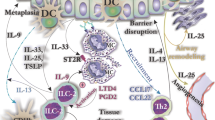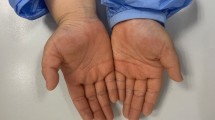Abstract
The nasal provocation test (NPT) could be more extensively used in the diagnosis of allergic rhinitis by practicing physicians. However, the procedure has not been standardized, and has mainly been utilized for scientific purposes in the US. This review illustrates a wide variety of techniques and approaches to dosing and concentration of allergen extracts, and delivery systems. It also outlines the lack of a unified outcomes-evaluation system, including clinical symptom scores and nasal patency measurements, in different countries. NPT is a safe, simple, and useful method when conducted with the consideration of indications and contraindications. Standardized NPT has the potential to become a more frequently used additional clinical test in the diagnosis of allergic rhinitis.
Similar content being viewed by others
References and Recommended Reading
Malm L, Gerth van Wijk R, Bachert C: Guidelines for nasal provocations with aspects on nasal patency, airflow, and airflow resistance. International Committee on Objective Assessment of the Nasal Airways, International Rhinologic Society. Rhinology 2000, 38:1–6. This paper gives the most recent international assessment of nasal provocation test and its evaluation.
Okuda M: Grading the severity of allergic rhinitis for treatment strategy and drug study purposes. Curr Allergy Asthma Rep 2001, 1:235–241. Detailed analyses of different grading systems for symptoms of allergic rhinitis, based on the last guidelines of WHO, FDA, EAACI, and the Japanese System, that helps to understand evaluation of clinical symptoms for positive or negative response in NPT.
Naclerio RM, Norman PS: In vivo methods for the study of allergic rhinitis. Mucosal tests, techniques, and interpretations. In Allergy: Principles and Practice, edn. 5. Edited by Middleton, E. St Louis: Mosby; 1998:440–453.
Bachert C: Nasal provocation test: critical evaluation. In New Trends in Allergy IV. Edited by Ring J, Behrendt HD. Berlin: Springer-Verlag; 1997:277–280. Good source of information for practitioners on performing NPT with allergen.
Holopainen E, Tarkiainen E, Malmberg H: Nasal challenge. Rhinology 1976, 14:181–188.
Stokes Peebles R Jr., Hartert TV: In vivo diagnostic procedures: Skin testing, nasal provocation and bronchial provocation. Methods 1997, 13:14–24.
Melillo G, Bonini S, Cocco G, et al.: Provocation tests with allergens. Allergy 1997, 52(Suppl 35):5–36.
Dykewicz MS, Fineman S: Executive summary of joint task force practice parameters on diagnosis and management of rhinitis. Ann Allergy Asthma Immunol 1998, 81:463–468. Complete guidelines for diagnosis and management of rhinitis contained the description of indications for the the use of NPT in office practice.
Testa B, Mesolella C, Testa F, et al.: Comparison of SPT and NPT in the ascertainment of nasal mucosa as shock organ. Rhinology 1996, 34:160–162.
Kanthawatana S, Maturim W, Fooanan S, Trakultivakorn M:Skin prick reaction and nasal provocation response in diagnosis of nasal allergy to the house dust mite. Ann Allergy Asthma Immunol 1997, 79:427–430.
Lavasa S, Kumar L, Kaushal SC, Ganguli NK: Wheat threshing dust—a "new allergen" in April-May nasobronchial allergy. Indian Pediatr 1996, 33:566–570.
Hytonen M, Sala E: Nasal provocation test in the diagnostics of occupational allergic rhinitis. Rhinology 1996, 34:86–90.
Gorski P, Krakowiak A, Pazdrak K, et al.: Nasal challenge test in the diagnosis of allergic respiratory diseases in subjects occupationally exposed to a high molecular allergen (flour). Occup Med (Lond) 1998, 48:91–97.
Passalacqua G, Albano M, Pronzato C, et al.: Long-term follow-up of nasal immunotherapy to Parietaria: clinical and local immunological effects. Clin Exp Allergy 1997, 27:904–908.
Stenius-Aarniala BS, Malmberg C, Holopainen E: Relationship between the results of bronchial, nasal and conjunctival provocation tests in patients with asthma. Clin Allergy 1978, 8:403–409.
Pelican Z: Late and delayed responses of nasal mucosa to allergen challenge. Ann Allergy 1978, 41:37.
Pelican Z: The late nasal response, its clinical and immunologic features, possible mechanisms and pharmacologic modulation. [thesis]. Free University in Amsterdam, 1996.
Horak F, Toth J, Hirschwehr R, et al.: Effect of continuous allergen challenge on clinical symptoms and mediator release in dust-mite-allergic patients. Allergy 1998, 53:68–72.
Del Prete GF, De Carli M, D’Elios MM, et al.: Allergen exposure induces the activation of allergen-specific Th2 cells in the airway mucosa of patients with allergic respiratory disorders. Eur J Immunol 1993, 23:1445–1449.
Andersson M, Greiff L, Svensson C, Person C: Various methods for testing nasal responses in vivo: a critical review. Acta Otolaryngol 1995, 115:705–713.
Walden SM, Proud D, Bascom R, et al.: Experimentally induced nasal allergic responses. J Allergy Clin Immunol 1988, 81:940–949.
Wang D, Smitz J, Derbe MP, Clement PA: Concentrations of myeloperoxidase in nasal secretions of atopic patients after nasal allergen challenge and during natural allergen exposure. Int Arch Allergy Immunol 1996, 110:85–90.
Sicherer S, Wood RA, Eggleston PA: Determinants of airway responses to cat allergen: Comparison of environmental challenge to quantitative nasal and bronchial allergen challenge. J Allergy Clin Immunol 1997, 99:798–805.
Fokkens WJ, Rowe-Jones JM: The management of perennial rhinitis—links between the nose, lung, asthma. Allergy 1997, 52(Suppl 36):20–28.
Adinoff AD, Corren J, Irvin CG: Changes in bronchial responsiveness following nasal provocation with allergen. J Allergy Clin Immunol 1992, 89:611–618.
Malm L, Angaard A, Howarth P, et al.: Nasal challenge. In Allergic and Nonallergic Rhinitis: Clinical Aspects. Edited by Mygind N, Naclerio R. Philadelphia: W.B. Saunders Co.; 1993:95–137.
Bousquet J, Francois-Bernard Michel: Diagnostic tests. In Allergy: Theory and Practice, edn 2. Edited by Korenblat PE, Wedner HJ. Philadelphia: W.B.Saunders Co.; 1995:156–163.
McLean JA, Bacon JR, Mathews KP, et al.: Effects of aspirin on nasal responses in atopic subjects. J Allergy Clin Immunol 1983, 72:187–192.
Demoly P, Campbell A, Lebel B, Bousquet J: Experimental models in rhinitis. Clin Exp Allergy 1999, 29:72–76.
Toppozada H, Toppozada M, El-Ghazzawi I, Elwany S: The human respiratory nasal mucosa in females using contraceptive pills. An ultramicroscopic and histochemical study. J Laryngol Otol 1984, 98:43–51.
Togias A: The role of enviromental allergens in rhinitis. In Asthma and Rhinitis. Edited by Busse W, Holgate S. Cambridge, MA: Blackwell Scientific Publications; 1995:1009–1033
Connell JT: Quantitative intranasal pollen challenge III. The priming effect in allergic rhinitis. J Allergy 1969, 43:33–42.
Yuta A, van Deusen M, Gaumond E, et al.: Rhinovirus infection and mucous hypersecretion. Am J Physiol 1990, 274:L1017-L1023.
Meltzer E, Schatz M, Zeiger R: Allergic and nonallergic rhinitis. In Allergy: Principles and Practice, edn 4. Edited by Middleton E. St. Louis: Mosby; 1993:1253–1288. This paper has description of technique and indications of the nasal provocation test.
Solomon WR: Nasal provocative testing. In Provocation Testing in Clinical Practice. Edited by Spector SL. New York: M.Dekker; 1995:647–692.
Wihl JA: Methodological aspects of nasal allergen challenges based on a three-year tree pollen immunotherapy study. Allergy 1986, 41:357–364.
Stankiewicz J, Ruta U, Gjorski P: Latex allergy. Int J Occup Med Environ Health 1995, 8:139–148.
Druce HM, Schumacher MJ: Nasal provocation challenge. J Allergy Clin Immunol 1990, 86:261–264.
Schumacher M, Borum P, Bachert C, Wihl JA: Fireside Conference: Nasal provocation test. Rhinology 1992, 14:S242-S246.
Bachert C, Gonsior E, Berdel D, et al.: Richtlinien fur die durchfuhrung von nasalen provokationstests mit allergenen bei erkrankungen der oberen luftwege [German]. Allergologie 1990, 13:53–55.
Naclerio R: Clinical manifestations of the release of histamine and other inflammatory mediators. J Allergy Clin Immunol 1999, 103:S382-S385.
Clement PA, Stoop AP, Kaufmann L: Histamine threshold and nasal hyperreactivity in nonspecific allergic rhinopathy. Rhinology 1985, 23:35–42.
Gerth vanWijk RG: Nasal hyperreactivity [thesis]. Rotterdam; Erasmus University, 1991.
Baraniuk JN: Neuropeptides. Am J Rhinol 1998, 12:9–16.
Borum P: Nasal methacholine challenge, a test for the measurement of nasal reactivity. J Allergy Clin Immunol 1979, 63:253–257.
Allergic rhinitis: clinical development for drug products. In Guidance for Industry. Rockville, MD: US Food and Drug Administration, Center for Drug Evaluation and Research; 2000.
Van Cauwenberge P, Bachert C, Passalacqua G, et al.: European Academy of Allergology and Clinical Immunology consensus statement on the treatment of allergic rhinitis. Allergy 2000, 55:116–134.
Linder A: Symptom scores as measures of the severity of rhinitis. Clin Allergy 1988, 18:29–37.
Jeney EV, Raphael GD, Meredith SD, Kaliner MA: Abnormal cholinergic parasympathetic responsiveness in the nasal mucosa of patients with recurrent sinusitis. J Allergy Clin Immunol 1990, 86:10–18.
Mygind N, Vesterhauge S: Aerosol distribution in the nose. Rhinology 1978, 16:131–136.
Pelikan Z, Feenstra L, Barree GOF: Response of the nasal mucosa to allergen challenge measured by two different methods of rhinomanometry. Ann Allergy 1977, 38:263–267.
Karger AG: Topical antigen provocation increases the number of immunoreactive IL-4, IL-5 and IL-6-positive cells in the nasal mucosa of patients with perennial allergic rhinitis. Int Arch Allergy Immunol 1997, 114:81.
Druce HM: Nasal provocation challenge—strategies for experimental design. Ann Allergy 1988, 60:191–194.
Baraniuk JN, Kaliner MA: Functional activity of upper-airway nerves. In Asthma and Rhinitis. Edited by Busse W, Holgate S. Cambridge, MA: Blackwell Scientific Publications; 1995:652–667.
Kurtz KM, Hamilton RG, Schaefer JA, Adkinson NF Jr: A hooded exposure chamber method for semiquantitative latex aeroallergen challenge. J Allergy Clin Immunol 2001, 107:178–184.
Roithmann R, Chapnik J, Zasmel N, et al.: Acoustic rhinometric assessment of the nasal valve. Am J Rhinol 1997, 11:379–385.
Taylor G, MacNeil AR, Frud DLJ: Assesing degree of nasal patency by measuring peak expiratory flow rate through the nose. J Allergy Clin Immunol 1973, 52:193–198.
Davies RJ, Corrado OJ: Diagnostic tests—challenge tests: oral, nasal and bronchial. In Allergy: Immunological and Clinical Aspects. Edited by Lessof MH. London: Wiley & Sons Ltd; 1984:83–105.
Eccles R: Rhinomanometry and nasal challenge. In Rhinitis: Mechanisms and Management. Edited by Mackay Ian. London: Royal Society of Medicine Services Ltd.; 1989:53–67.
Naclerio R, Togias A, Flowers B, et al.: Nasal lavage: a technique for elucidating the pathophysiology of allergic rhinitis. In Rhinitis and Asthma: Similarities and Differences. Edited by Mygind N, Pipkorn U, Dahl R. Copenhagen: Munksgaard; 1990:213–222.
Raphael GD, Druce HM, Baranuik JN, Kaliner MA: Pathophysiology of rhinitis. 1. Asssessment of the sources of protein in methacholine-induced nasal secretions. Am Rev Respir Dis 1988, 138:413–420.
Bisgaard H, Krogsgaard OW, Myding N: Measurement of secretion in nasal lavage. Clin Sci 1987, 73:217–222.
Linder A, Strandberg K, Deuschl H: Histamine concentrations in nasal secretion and secretory activity in allergic rhinitis. Allergy 1987, 42:126–134.
Kaulbach HC, White MV, Igarashi Y, et al.: Estimation of nasal epithelial lining fluid using urea as a marker. J Allergy Clin Immunol 1993, 92:457–465.
Baroody FM: Mucosal cytology. In Rhinology and Sinusology: Rhinologic Diagnosis and Treatment. Edited by McCaffrey TV. New York: Thieme Medical Publishers; 1997:175–192.
Meltzer E, Jalowayski A: Nasal cytology in clinical practice. Am J Rhinol 1988, 2:47–54.
Pipkorn U, Karlsson G: Methods for obtaining speciments from the nasal mucosa for morphological and bioichemical analysis. Eur Respir J 1988, 1:856–862.
Baraniuk J: Mechanism of allergic rhinitis. Curr Allergy Asthma Rep 2001, 1:207–127.
Christodoulopoulos P, Cameron L, Durham S, Hamid Q: Molecular pathology of allergic disease. II: Upper airway disease. J Allergy Clin Immunol 2000, 105:211–223.
Author information
Authors and Affiliations
Rights and permissions
About this article
Cite this article
Litvyakova, L.I., Baraniuk, J.N. Human nasal allergen provocation for determination of true allergic rhinitis: Methods for clinicians. Curr Allergy Asthma Rep 2, 194–202 (2002). https://doi.org/10.1007/s11882-002-0019-9
Issue Date:
DOI: https://doi.org/10.1007/s11882-002-0019-9




